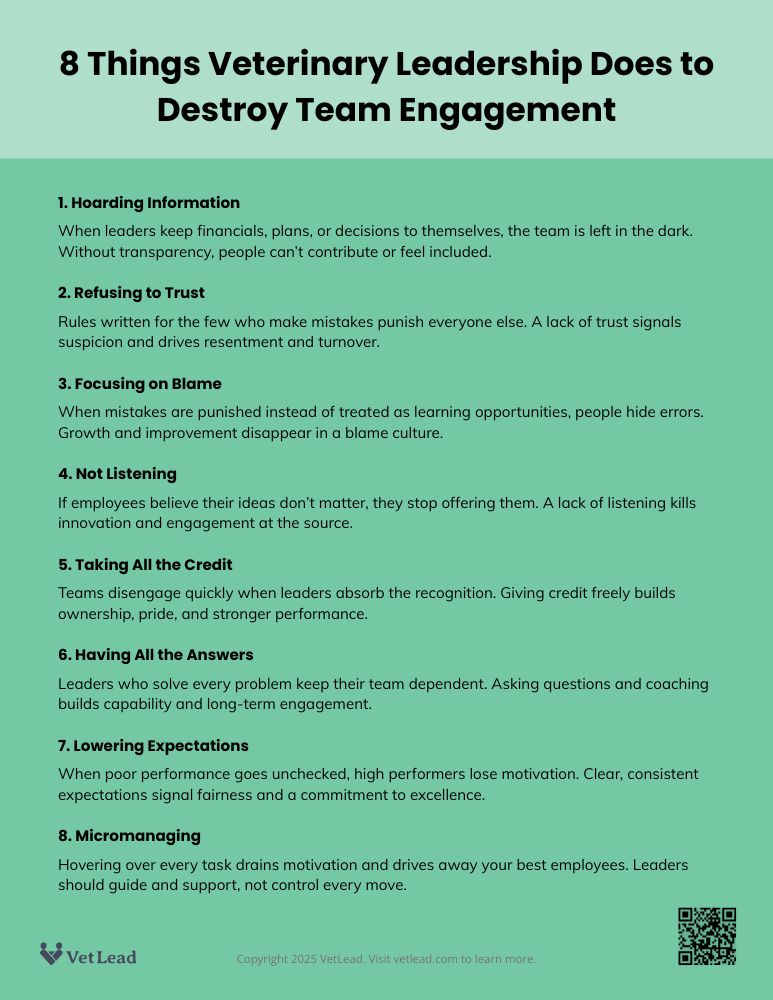It’s hard to imagine a veterinary leader waking up in the morning and deciding to disengage their team. Most of us want exactly the opposite. We want people who show up, contribute fully, and feel proud of the care we provide together. But the reality is that certain management behaviors quietly destroy engagement every day in veterinary practices. They don’t always happen on purpose, and many leaders don’t even notice they’re doing them. Still, the impact is the same.
Engagement is not just nice to have. It affects how your team communicates with each other, how they treat clients, and how they care for patients. When engagement is high, your practice feels alive. When it is low, the best employees look for other opportunities, the rest check out mentally, and the culture starts to erode.
8 Ways Veterinary Leadership Destroys Team Engagement
Let’s walk through the most common leadership behaviors that undermine engagement in veterinary practices. They may feel small in the moment, but over time they make a big difference in how your team shows up.
1. Hoarding Information
Veterinary managers sometimes keep information to themselves. Maybe it’s financial results, plans for the future, or even day-to-day decisions like hiring. The fear is that people will react badly, get distracted, or not understand. But when leaders hold back too much, the team is left in the dark. They can’t contribute ideas, prepare for change, or feel included in the direction of the practice.
When staff members say things like, “I heard through the grapevine we’re changing computer systems,” or “No one told me we hired someone new,” that’s a red flag. If people only learn what matters through gossip or last-minute announcements, they will never feel like true partners in the practice.
2. Refusing to Trust
Some veterinary practices have employee handbooks filled with rules because of what one or two people did in the past. Phones locked in lockers, docking pay for failing to clock in, endless approvals before anyone can make a decision. All of these communicate the same message: “We don’t trust you.”
Imagine being a new vet tech walking into that environment. You’ve done nothing wrong, but you’re already treated as if you will. That is not a recipe for engagement. When leaders don’t trust, they create resentment, slow progress, and encourage turnover.
3. Focusing on Blame
Mistakes happen in every practice. The question is how leaders respond. Do we immediately look for who is at fault? Do we punish or embarrass the person? Or do we treat mistakes as part of the learning process?
A culture of blame makes people hide errors, cover them up, or deflect responsibility. A culture of learning encourages people to own their mistakes, share them, and help build better systems. Engagement dies in environments where the main goal is avoiding punishment instead of learning and improving.
4. Not Listening

One of the fastest ways to disengage a team is to stop listening to them. If staff members feel like their ideas go nowhere, they’ll stop offering them. Managers who dominate every meeting with what they want to say often miss the opportunity to learn what their team already knows.
Employees want to contribute. They want to solve problems. But when the only process for improvement is “management will fix it,” engagement disappears. Listening isn’t just about asking for input; it’s about demonstrating that ideas matter, questions will be considered, and solutions can come from anywhere in the practice.
5. Taking All the Credit
It’s tempting as a leader to believe you’re the one keeping the practice afloat. You work long hours, juggle problems, and make hard decisions. But if you’re doing veterinary leadership right, your team is part of every win. If they don’t feel recognized for that, they disengage.
Research shows the difference clearly. Forbes reported on a study of more than 3,800 leaders. Those who grabbed credit for themselves were rated among the least effective leaders in the study. The ones who gave credit freely were rated among the best. It wasn't a small gap. Recognition is powerful, and when it is absent, engagement plummets.
6. Having All the Answers
Some leaders think their job is to solve every problem, provide every answer, and always be the expert. The truth is, that approach keeps the team dependent and disengaged. People don’t grow when they are spoon-fed solutions.
Think about how you would help a child with a homework problem. You wouldn’t just hand them the answer. You’d ask questions, guide them, and help them learn. It’s the same in a veterinary hospital. Great leaders use questions to coach, not quick answers to control. Engagement grows when people feel capable, not when they feel managed.
7. Lowering Expectations
Engagement dies when leaders relax expectations instead of raising them. If someone comes in late or shows up with a bad attitude and nothing is said, the message is clear: expectations don’t matter. That discourages high performers and allows mediocrity to take root.
Lowering expectations to avoid conflict might feel easier in the moment, but it creates bigger problems later. People want to be part of a team where excellence is the standard. When they see leaders tolerate less, they start caring less.
8. Micromanaging
No one wakes up excited to be micromanaged. Hovering, checking every step, and correcting constantly destroys engagement faster than almost anything else. The best employees usually leave first when micromanagement is the norm. The rest either disengage or never develop.
Micromanagement might feel like it prevents mistakes, but in reality, it prevents growth. Leaders who can’t let go of control end up with tired teams, high turnover, and no real engagement.

8 Ways Veterinary Leadership Destroys Engagement
Download this free resource, share it with leaders and teams. No email address required.
Shifting Toward Engagement
If these eight habits erode engagement, what builds it back up? It often comes down to coaching. Coaching is not about manipulation or getting people to do what you want. It’s about helping them become more successful in ways that matter to them.
When leaders choose to coach, they listen more, ask questions, and support growth instead of assigning blame. They allow people to take part in decisions rather than handing down orders. They see mistakes as progress, not failure. And they set high expectations while offering the support their team needs to reach them.
Engagement is not created by eliminating mistakes or making all the decisions yourself. It’s created when leaders invest in capability, share information openly, and create an environment where people feel trusted and valued. Coaching is the process that ties all of those things together.
Engagement Starts With Leadership Choices
Veterinary practices don’t lose engagement because employees stop caring. They lose it when leaders unintentionally create conditions where caring no longer matters. The good news is that leaders can also create the opposite. With intentional choices, clear expectations, and a coaching mindset, you can build a practice where engagement is the rule, not the exception.
Want resources and processes to build engagement in your own practice? Start your free 30-day VetLead Membership today, no credit card required.
What do you think? Other veterinary pros want to hear from you! Share your experience in the comments below.